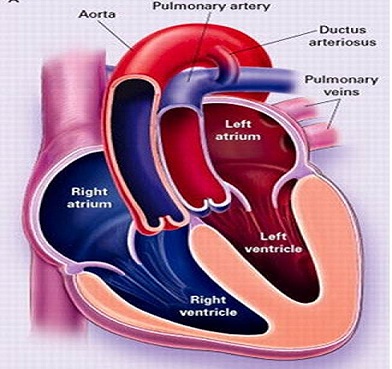Transposition of the great vessels pathophysiology
|
Transposition of the great vessels Microchapters |
|
Classification |
|---|
|
Differentiating Transposition of the great vessels from other Diseases |
|
Diagnosis |
|
Treatment |
|
Surgery |
|
Case Studies |
|
Transposition of the great vessels pathophysiology On the Web |
|
American Roentgen Ray Society Images of Transposition of the great vessels pathophysiology |
|
Transposition of the great vessels pathophysiology in the news |
|
Risk calculators and risk factors for Transposition of the great vessels pathophysiology |
Editor-In-Chief: C. Michael Gibson, M.S., M.D. [1]; Associate Editor(s)-In-Chief: Priyamvada Singh, M.B.B.S. [2]; Cafer Zorkun, M.D., Ph.D. [3]; Keri Shafer, M.D. [4]; Kristin Feeney, B.S. [5]
Overview
Anatomy
Normal Heart
- Normally, the morphologic right atrium (RA) is connected to a morphologic right ventricle (RV). The morphologic left atrium (LA) is connected to the morphologic left ventricle (LV). This is called atrio-ventricular concordance.
- In a normal heart, the great arteries (aorta and pulmonary arteries) are concordant with the morphologic LV and RV. This is termed ventriculo-arterial concordance.
- In addition, the aorta and pulmonary trunk ascend in a spiral relationship.
Transposition of the great vessels
- In the TGA the aorta arises from the morphologic right ventricle via a subaortic infundibulum and the pulmonary artery arises from the morphologic left ventricle, without a subpulmonary infundibulum. These ventriculoarterial connection is known as ventriculoarterial discordance. As a consequence, there is a a fibrous continuity between the mitral and pulmonary valve, but no continuity between the tricuspid and aortic valve.
- The abnormal origin of the great arteries results in an altered spiral relationship. Therefore, the aorta and pulmonary artery run parallel to each other
- In normal heart thus the circulation is in series. However, in transposition of the great vessels circulation is in parallel
dextro-Transposition of the great vessels
- d-TGA is also referred to as complete or uncorrected transposition of the great arteries identifying the single discordance between ventricles and great arteries
levo-Transposition of the great vessels
- l-TGA is referred to as congenitally corrected transposition, identifying a double discordance (atrioventricular and ventriculoarterial).
Pathophysiology
Diagram showing a normal heart compared to heart with transposition of the great arteries

Fetal Ciculation→Oxygen-rich blood from placenta(drains to)→Umbilical vein (drains to)→Right atrium (drains to) →Fossa ovalis(drains to)→Left ventricle (drains to)→The pulmonary artery(drains to)→Ductus arteriosus(drains to)→Descending aorta
The fetus circulation in-utero is different compared to the extra-uterine circulation. The fetus tolerates a D-TGA well in-utero due to this difference in circulation. The high resistance in the pulmonary circulation compared to the placenta, allows the blood to flow to the descending aorta rather than to the lung. Due to this the fetus gets blood with a higher oxygen tension.
Pathophysiology in Dextro-TGA in extra-uterine life-
- In normal cardiac anatomy, the aorta is positioned posterior and to the right of the main pulmonary artery. Aorta being positioned anterior and slightly rightward of the pulmonary artery. These changes cause the aorta to arise from the right ventricle and the pulmonary artery from the left ventricle (ventriculoarterial discordance).
- In Uncorrected D-TGA the systemic and pulmonary circulations are parallel circuits which means that the deoxygenated systemic venous blood comes to the right ventricle and inplace of going to the lungs, drains back to the systemic circulation via the aorta. Similarly, oxygenated pulmonary venous blood is recirculated to the lungs via the pulmonary artery.
- This parallel circulation is incompatible to life.
- For a child with dextro-TGA to survive, a communication between the two parallel circuits is necessary.
- Various connections that allow mixing in these patients are: patent foramen ovale, ventricular septal defect, atrial septal defect,patent ductus arteriosus or the bronchopulmonary collateral circulation.
- Ventricular septal defect (VSD) occurs (in about 50%) of patients with D-TGA. Patients with a VSD may have other cardiac anomalies like pulmonary stenosis or atresia, overriding of atrioventricular valve, and coarctation of aorta.
- Left ventricular outflow tract obstruction is common in D-TGA and is present in up to 25 percent of patients.
Below is an image depicting the abnormal flow in the large vessels of the heart.

Associated Conditions
- Ventricular septal defect
- Pulmonary stenosis
- Left atrioventricular valve regurgitation (tricuspid or systemic)
- complete heart block